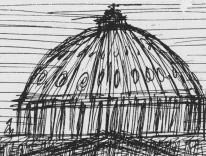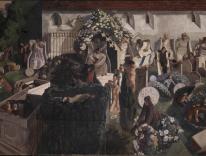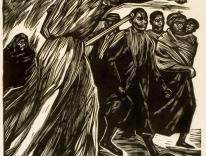A lifeline is a rope you toss into the water to save someone struggling to stay afloat. Metaphorically, it describes a person or resource you depend on for survival, especially in dire situations. In the arts of divination, lifelines are those wrinkles on your palm that predict how long you’ll live. Visually, with their rising, falling, twisting, and turning, lifelines can also reflect the character and trajectory of a person’s life.
All of these senses are present in the life and work of C. C. Wang (1907–2003), the Chinese-born American artist at the center of a retrospective exhibition this spring at the Hunter College Art Galleries in New York City. Wang holds a significant place in the history of twentieth-century American art. He was one of the most influential collectors and connoisseurs of Chinese painting (tenth through eighteenth centuries) in the world. Today, works from Wang’s collection can be found in prominent museums and universities across the country, including in Boston, New York, Princeton, Chicago, Cleveland, and San Francisco.
Besides serving as a mentor to generations of scholars and curators of Chinese art, Wang was also a talented artist in his own right. Curated by Wen-shing Chou and Daniel M. Greenberg with Margaret Liu Clinton, C. C. Wang: Lines of Abstraction powerfully demonstrates Wang’s achievement through a range of intriguing works. The show grew out of collaborative seminars taught by Chou at Hunter and Greenberg at the University of Minnesota. A deeply researched, richly illustrated catalog, the first book to focus on Wang as an artist, has also been published in tandem with the exhibition.
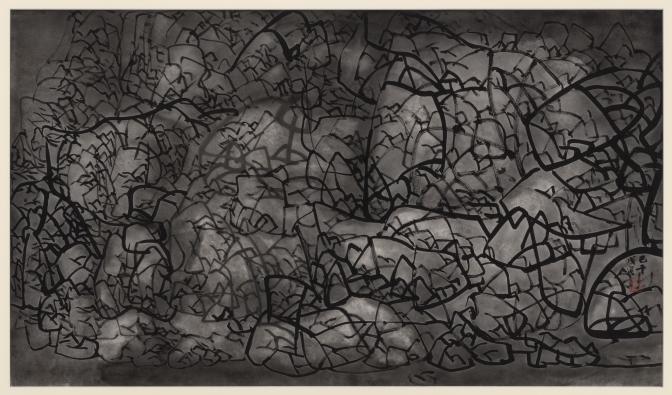
One of the most striking works on display is No Title (Abstract Work in Monochrome) (1998), a monochromatic painting done with ink on paper. Strokes of black ink rise, fall, and swoop across the surface. Sometimes the lines veer back on themselves to form boxy loops; other times they make sharp acute angles. A few are dense and rich with ink, while others reveal instances when Wang’s brush was drier, yielding fainter, staccato-textured marks.
Although entirely abstract, the work resembles a landscape. Wang’s variation of lines and overlapping of forms render a sense of depth and distance, with a foreground seemingly receding into a background. Washes of gray ink appear luminous in certain areas and smoky in others, alternately evoking the contours of earthen mounds or the effervescence of the atmosphere. Throughout, the quavering lines evoke the swift, rhythmic flow of movement initiated by Wang’s wrist and arm. Wang made this work when he was in his nineties, and it’s emblematic of the artist’s lifelines: not a single, straight line moving in one direction, but many lines traveling different paths and coalescing into a unified whole.
Wang was born in 1907 in Suzhou, China, to a literati family. Then in their twilight years, the literati comprised an elite social class of scholars and officials who had formed the heart of China’s state bureaucracy since the tenth century. This privileged group emphasized self-cultivation and the pursuit of knowledge. It also developed its own educational program, which Wang and his generation were among the last to receive.
As students, young literati were expected to learn not only classical Chinese texts and essay composition, but also to master calligraphy and landscape painting. Their training with brush and ink was in fact a full-body exercise: dots, lines, washes, and stains were rendered with subtle variations on the position and pressure of the brush in one’s hand, guided by the choreography of arm and body moving across paper.
To build tactile and experiential fluency, literati artists ideally maintained a lifelong practice of copying the works of earlier masters. This not only increased their own repertoire of skills and improved their technique, but also facilitated a kind of spiritual communion and embodied dialogue with centuries of preceding artists.
Adherence to the practice of copying did not imply a lack of originality or individual expression. Literati pedagogy aimed to prepare individual artists to discover their own paths through expertise in ancient methods. Over the centuries, there evolved a rich lexicon of techniques named for the individual literati artist who had originated or exemplified them: the “raindrop” method of Fan Kuan (ca. 990–1030), the sustained “single stroke” of Shitao (1642–1707), or Guo Xi’s (1020–1090) practice of meditating on his walls to find inspirational patterns. Each artist made their own original contribution—their “mark,” so to speak—to the lineage.
Repetitive emulation of past masters also trained literati artists to become connoisseurs. When examining a particular brushstroke or detail in a painting, they could use their intimate, physical knowledge of an array of techniques to determine exactly who had painted it. Such connoisseurship predisposed literati to be natural collectors. Before the advent of photographic reproductions and public museums, the only way of studying original Chinese artworks was to own them yourself, or to know someone else—usually a literati artist—who did. Appreciating, authenticating, buying, selling, and displaying literati art were all part and parcel of the artist’s vocation.
In 1949, as the Communist Party rose to power in mainland China, Wang, then forty-two, immigrated with his wife and two youngest daughters to New York City. Wang had studied law in Suzhou and Shanghai, which gave him a familiarity with English. A life in the United States seemed like a favorable prospect.
Expertise in Chinese painting was scant at the time in the United States, and American curators, collectors, auction houses, and museums eagerly sought Wang’s guidance. In New York, the Metropolitan Museum of Art hired him as an appraiser and consultant for their collection of Chinese art. Wang’s mentorship to young American scholars helped catalyze the burgeoning field of Chinese art studies in this country, with some of Wang’s protégés going on to become professors of Chinese art history at Princeton, Yale, and Berkeley.
Alongside his teaching, mentorship, and connoisseurial work, Wang continued his own artistic practice. True to the literati spirit of self-cultivation, between 1949 and 1974 he enrolled in forty courses—mostly in anatomy and life drawing, focused on the fundamentals of Western art—at the Art Students League of New York. Wang had a particular appreciation of European modernists, especially post-impressionists such as Van Gogh, Gauguin, and Cézanne. He was drawn to their use of vibrant color and inventive design and composition—elements of artmaking that had not been emphasized in his literati training.
Wang’s studies inspired him to experiment with new techniques and materials in his literati painting. In a landscape from 1985, Wang pays homage to Fan Kuan by emulating the classical painter’s monumental Travelers among Mountains and Streams (ca. 1000). Here Wang transforms Fan Kuan’s signature “raindrop” technique of applying miniscule brushstrokes to the mountain to convey its textured surface. Instead of a brush, Wang used a roller wrapped in crumpled, ink-dipped paper to render semi-accidental, semi-random impressions onto the work’s surface. He then used a brush to add lines and washes to the printed creases, bringing out the other forms of the landscape. Fan Kuan theorized that literati painting was less an imitation of nature than a continuation of its processes. Just as the ancient master’s tiny brush strokes mimic falling rain, so too does Wang’s crumpled-paper method mirror nature’s constant, haphazard imprinting of mountain landscapes.
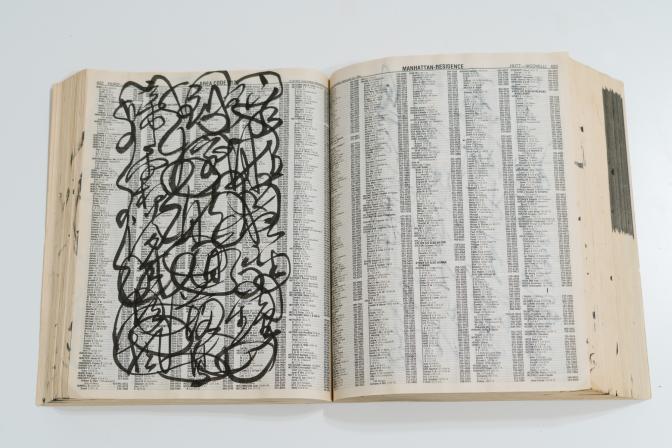
After Wang received U.S. citizenship in 1957, he made frequent trips to Hong Kong and Taiwan, where he reunited with other literati artists who had left mainland China. There, he also encountered a younger generation of artists who were using traditional Chinese materials to explore abstraction. With his own painting students, however, Wang’s teaching was always rooted in the traditional literati method of copying and emulating old masterworks, a practice he continued for the rest of his life.
In the 1990s, when Wang was in his eighties, he began a daily routine of practicing ink calligraphy on the pages of old New York City phone books. The characters and quotations came from the classical Chinese texts he had memorized since boyhood. The pages range from legible standard and cursive Chinese script, to semi-legible characters, to highly abstract compositions. Visible throughout is the inherent beauty and playful potential of the calligraphic line.
Wang considered these objects to be practice books, and he never intended to exhibit them. Still, with their traditional quotations and experimental brushwork literally supported by a symbol of the modern, interconnected metropolis, Wang’s phone books capture something essential about him, and about the intimate, communal nature of the literati tradition he incarnated. Too often—due in part to the dominance of abstract expressionists such as Jackson Pollock, Willem de Kooning, and Mark Rothko—we think of abstraction as the result of a radical, individualistic break with tradition, as if artistic “progress” were a straight line pointing in one direction. Wang’s life—and the consistent way he looked back to the literati tradition even as he experimented with abstraction and new methods—instead assumes the more dynamic, elastic form of a spiral, circling back to the past even as it traces a path forward.
